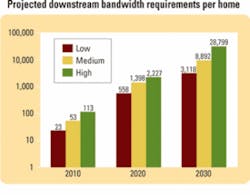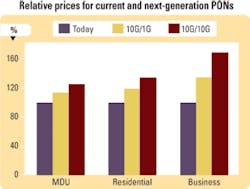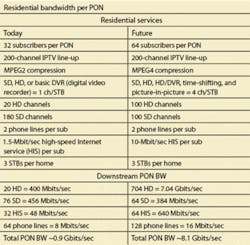by Tom Anderson
Passive optical networks (PONs) are on the cusp of a new generation. Services, bandwidth, and economics are evolving and combining to move PON from being simply an elegant approach to greenfield projects into broader acceptance as the access network of choice for both telephone companies and multiple systems operators (MSOs). PONs, originally conceived as residential networks, now support business services and are considered affordable alternatives to copper and coax infrastructure. However, while today�s PONs deliver today�s services very well, they will soon become overtaxed by tomorrow�s service requirements.Thus, the next generation of PONs is less about new features and more focused on bandwidth expansion. Services are migrating from 10/100 Mbits/sec toward fractional Gigabit Ethernet (GbE), GbE, and beyond. The next generation of PON will be characterized by more bandwidth and lower price per megabit than today�s systems.
There are two factors driving network operators to more bandwidth in the access network�video and business services.
Video is by far the largest driver. Figure 1 shows a projection from The Fiber to the Home Council and Current Analysis of bandwidth needs per home. Starting with sub-100-Mbit/sec services in 2010, they expect a tenfold increase in demand per decade, reaching as much as 10 Gbits/sec per home by 2030.Drilling down a level, the table on page 28 details residential service drivers. Consumer demand for more high-definition channels, added video streams, and time-shifted television has network operators scrambling to stay ahead of their subscribers� bandwidth appetite. Today�s access networks, even PONs, will not support tomorrow�s needs.
As illustrated in the table, bandwidth needed per home is more than quadrupling from today�s requirements. In the not-so-distant future, demand per home will increase from about 30 Mbits/sec per subscriber to more than 125 Mbits/sec. Today�s GEPON and GPON technologies that deliver 1 Gbit/sec and 2.5 Gbits/sec, respectively, with a 32-split topology are adequate for today. But as more HDTV channels and video services are added to the service lineup, today�s PONs will fall short. With 64 splits, next-generation PON systems will need to supply 8.1-Gbit/sec payloads to meet the demand. Even if the next-generation topology only matches today�s 32 splits per PON, more than 4 Gbits/sec will be required for residential deployments, which is well beyond today�s PON capabilities.
Residential bandwidth usage tends to be asymmetric. Downstream bandwidth is consumed with video while upstream is largely high-speed Internet services with a smattering of voice. This asymmetry plus increasing downstream bandwidth demand are the drivers of one incarnation of next-generation PON: 10 Gbits/sec downstream and 1 Gbit/sec upstream (10G/1G) per PON payload.
IEEE has a working group focused on these 10G PON standards including 10G/1G PONs. GEPON systems are anticipated to have 10G standards in late 2008.
Business services are the second major driver of bandwidth requirements and thus next-generation PON. Even though today�s PONs feature commercial-quality capabilities, bandwidth and operational concerns have slowed their use in business applications. This has caused service providers to sometimes resort to separate networks for the business services market.But network operators are under increasing competitive pressure to drive down network costs. Two networks are more expensive to install and operate than one network. Service providers also have come to realize the inherent cost benefits of PON over other network topologies. Thus, extending PON to address the demands of small and large business subscribers is attractive.
However, business services bring new requirements for bandwidth, reaching 1 Gbit/sec and beyond for some business subscribers. In contrast with the asymmetric nature of residential services, business bandwidth needs tend to be more symmetrical. File sharing, SAN applications, and the like are driving upstream bandwidth requirements to be as great as or even greater than downstream capacity. Clearly, asymmetric 10G/1G next-generation PONs cannot address business needs. That has standards bodies such as IEEE working on a second incarnation of next-generation PONs with 10G downstream and 10G upstream (10G/10G) PON definitions.
The next generation of PON systems will accommodate payloads of both 10G/1G for residential and 10G/10G for business applications. Not only does the fiber plant topology support dual bandwidth plans, but also the economics make sense, as discussed later in this article. The IEEE has a working group focused on 10G/1G standards that is addressing 10G/10G PON operation as well, with GEPON systems anticipating a full set of 10G standards in late 2008.
The bandwidth projections in Fig. 1 and the table assume that video is delivered as IPTV. While IPTV is commonly regarded as the preferred future video delivery technology, implementations so far generally have been problematic. Realizing this, many network operators have stepped back from IPTV deployments, opting for PON systems that support downstream video using an optical RF overlay. By doing so, PON systems offload the video bandwidth burden from the PON IP traffic. Next-generation PON systems must support this RF video at least until the IPTV implementation snags are worked out. Indeed, many if not most of today�s PON systems support downstream RF video.
But RF video services are becoming increasingly interactive, requiring upstream communications from devices such as set-top boxes and cable modems. The next generation of PON will deal effectively with this upstream path. That is being accomplished in the optical RF domain with a technology termed hybrid RF PON (Fig. 2). Wavelengths shown are examples and may vary.
In the hybrid RF PON architecture, four wavelengths are used to deliver services. Two of them are for RF downstream and upstream, the other two are for IP upstream and downstream. This topology allows for high-bandwidth downstream RF video to use PON spectrum that is independent from the IP bandwidth while using traditional upstream RF equipment. Data and voice are carried separately from video on the PON. This next-generation PON arrangement is most useful for network operators with an existing two-way RF infrastructure.
A variation of the hybrid RF PON architecture is more useful for operators with one-way (downstream-only) RF. In this next-generation topology, video is again sent downstream as RF, but the upstream path for interactive video controls is carried upstream as Ethernet as shown in Fig. 3.
The MSO community is interested in using the optical RF portion of hybrid RF PON architecture (termed RFoG�RF over glass) as a migration path from hybrid fiber/coax to an all-fiber network. Indeed, a number of MSOs are realizing significant cost savings and revenue increases by deploying RFoG technology. The community is currently investigating the desirability of a standard for RFoG/hybrid RF PON. Further developments toward standardization are expected later in 2008.
Along with greatly increased bandwidth, the topology of next-generation PONs will change. Today�s PON architectures support 32 optical network terminals (ONTs) with an optical budget reaching 20 km. That means cost-per-subscriber analysis, commonly used by network operators to determine project feasibility, amortizes optical line terminal (OLT) costs across 32�N subscribers (N = number of PONs per system). With low ONT costs plus a relatively high cost for OLTs, reaching an acceptable return on investment (ROI) can be challenging.Next-generation PONs are expected to support at least 64 ONTs per PON, with the same 20-km reach as today�s networks. A 128-split architecture is being considered for shorter-reach applications. With higher split ratios, the OLT component of cost-per-subscriber drops dramatically. It is halved with 64 splits and reduced to one quarter when 128 splits are compared to a 32-split PON system. That improves the ROI analysis dramatically, making the difference between a profitable project that generates revenue and one that is abandoned.
Today�s PON systems were optimized for residential services. Ethernet and voice ports are universally available, but T1/E1 services were seldom contemplated. PON systems have now become viable alternatives for business services, a market in which T1/E1 services continue to grow for wireless backhaul and business voice applications.
Recognizing this, successful next-generation PON systems will embrace TDM services. Some PON vendors currently support T1/E1 connectivity, but it is not universally available. Next-generation PONs will fully provide the low latency and jitter performance necessary for backhaul service-level agreement quality performance.
Another aspect influencing next-generation PONs is their use in brownfield applications. Current-generation PONs have most often been used for greenfield deployments. Their economics and system capabilities are justified where the �last mile� is new construction with fiber extending all the way to the residence or business. Moving forward, there are three factors driving PONs into brownfield opportunities:
- Consumers are demanding services that cannot be supported with the current infrastructure.
- Competition is providing equal or better services over lower-cost fiber networks.
- Network operators have become more familiar with PON systems and economics. PON is a proven technology that service providers understand.
There is a significant difference between brownfield and greenfield installations�the drop connection to the home. Deploying fiber drops in new construction is easy compared to brownfield situations where, just to get access, installers deal with fences, flowerbeds, walkways, and dogs. For brownfields, if new drop wiring can be avoided, network operators can save significant deployment time and expense.
So as PON migrates to brownfield applications, the next-generation systems will use the existing drop wiring whenever possible. Typically, PONs will be constructed with a fiber-to-the-curb (FTTC) architecture. ONTs often will be installed near but not at the subscriber location. Technologies such as VDSL2, BPL, and MoCA will make use of the existing copper and coax to avoid the cost of drop installation and rewiring customer premises. Though these technologies will not supply the bandwidth available from next-generation FTTH architectures, they will be a practical compromise for some network operators.
10G next-generation networks offer significant capital savings per megabit of service over current-generation PON systems, although they may cost more in absolute terms. Here are a few considerations.
First, 10G PON systems inherently cost more than today�s 1G and 2.5G systems. The optical components for 10G PON systems are more expensive. Currently, 1G and 2.5G optics are roughly equivalent in price. Comparable 10G optical elements cost 4� to 8� more. Other hardware needed to process 10G services through the access networks is more expensive as well. Although there is a portion of the circuitry unaffected by a change to 10G operation, the switching and processing elements that are affected will cost about double current technology. Of course, it is reasonable to expect technology advances and increased volume to reduce those differences over time.
In the meantime, it is valuable to compare bandwidth gains against price differences. From this perspective it becomes clear that the large bandwidth defining next-generation PONs will be gained at a small price premium.Considering price per megabit, the capital cost of a 10G/1G or 10G/10G system is considerably less than today�s PON equipment. A price model for next-generation systems is reflected in Fig. 4. By normalizing the per-subscriber price of today�s GPON or GEPON system to 100%, the price for next-generation PON systems can be compared in terms of the premium paid for the additional bandwidth. Thus, for residential applications, a 19% price increase buys downstream bandwidth expanded to 10 Gbits/sec, and 34% gains symmetrical 10-Gbit/sec PON payloads. Business applications can get the same next-generation improvements for 34% and 67%, respectively, and MDU applications only cost an additional 14% and 26%.
Why the premium differences among residential, MDU, and business applications? Each requires different ONTs optimized for the application. The number of ports, port types, environmental conditioning, and variations in services supported contribute to ONT prices differing by a factor of 20 or more. Also, each application spreads OLT and ONT costs across varying subscriber counts. For example, a single business ONT might serve a single subscriber, while a single ONT in an MDU application might serve 24 subscribers. For a PON loaded with ONTs in 32 different locations, the costs of OLT and ONTs could be spread across 32 subscribers or as many as 768.
PONs are coming of age. The next generation of PON systems is being defined to move beyond today�s requirements for residential and business applications to become a complete access network with capacity for expanding bandwidth demand.
Next-generation PONs will be characterized by several factors, including:
- 10-Gbit/sec bandwidth in either downstream-only or symmetrical configurations.
- Bandwidth for IP video and high-capacity business services.
- Two-way support for interactive RF video.
- Higher split ratios�64 or 128 ONTs per PON driving better economics.
- TDM T1/E1 services being universally available for business subscribers.
- Better options for brownfield deployments, using existing drop wiring.
- Economics with significantly lower cost-per-megabit structures and improved cost-per-subscriber points.
The key advantage of next-generation PON systems is bandwidth. Support of 10 Gbits/sec is necessary for anticipated services and is achievable with available technology. Next-generation 10G PONs will soon become viable and cost-effective platforms for tomorrow�s network.
Tom Anderson is director of product marketing at Alloptic (www.alloptic.com).





